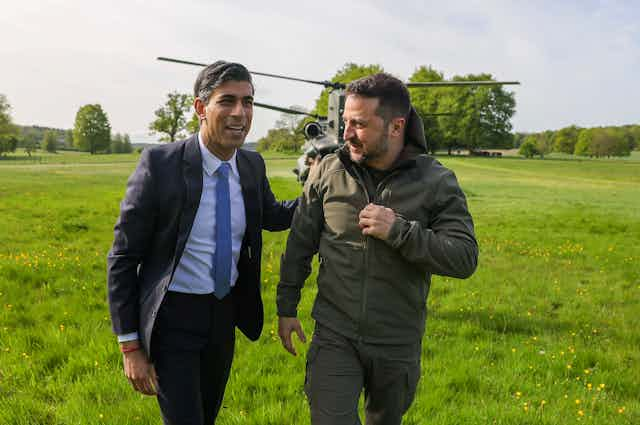As the war in Ukraine intensifies, President Volodymyr Zelensky has concluded a series of successful visits to Rome, Berlin, Paris and London to shore up support from key allies.
The timing of Zelensky’s visit is critical for Ukraine’s efforts on the battlefield and beyond. It has allowed the Ukrainian president and his main European allies to coordinate their approach on the economic and diplomatic fronts of the war as well, which will be equally decisive in determining how this war will end, and when.
Military support from his allies has been on top of Zelensky’s agenda during his whistle-stop tour of Europe. And finally, it seems that Ukraine’s European allies are following in Washington’s footsteps and moving beyond their earlier hesitation to provide Kyiv with more equipment for its upcoming counter-offensive in Bakhmut.

On Saturday, May 13, ahead of Zelenskiy’s arrival in Berlin, Germany announced a further €2.7 billion (£2.35 billion) of support, including much-needed quantities of artillery ammunition. In addition, German arms manufacturer Rheinmetall confirmed a joint venture with Ukraine’s Ukroboronprom to build and repair tanks in Ukraine.
On Sunday, May 14, Zelensky secured promises in Paris from the French president, Emmanuel Macron, for new armoured vehicles and air defence systems.
On Monday, May 15, British prime minister Rishi Sunak agreed to provide Ukraine with hundred of attack drones, in addition to the Storm Shadow cruise missiles that have already been delivered to strengthen Ukraine’s air defences.
These commitments are important for providing Ukraine with the ammunition, equipment, training and repairs the country needs against a Russian adversary that has significant manpower advantages.
This does not guarantee a sweeping success of the anticipated Ukrainian counter-offensive, but it will make serious gains on the battlefield more likely for Kyiv. And it signals a commitment by its western partners to back this offensive with more than encouraging noises.
The sanctions game
The war in Ukraine is not only fought, and can not only be won, on the battlefield. From the beginning, the western approach was twofold: strengthen Ukraine and weaken Russia.
The latter was achieved through unprecedented sanctions, with the EU now on its tenth sanctions package since Russia annexed Crimea in 2014. The EU is now discussing the eleventh sanctions package, this time with a focus on enforcing existing sanctions and closing loopholes by imposing secondary sanctions against countries, companies and individuals deliberately circumventing the existing sanctions against Russia.
Sanctions will also be discussed at the G7 summit in Hiroshima, Japan, from May 19 to 21. Further measures are expected to target the Russian energy sector and place more limitations on exports to Russia.
The four European countries Zelensky visited in the past few days – France, Germany, Italy and the UK – are all members of the G7, while the EU attends as an observer. Including other members the US, Japan and Canada, the G7 represents some of Ukraine’s most powerful partners who will send an unambiguous message to Russia concerning sanctions and their enforcement.
This will not break the Russian war machine, but it will make it more costly, including for Russia’s few remaining allies, to sustain the war effort in Ukraine at the current level. Seen from this longer-term perspective, it also makes Ukrainian gains in any counter-offensive more sustainable by limiting Russia’s capabilities to mount any offensives in the future.
The third front: diplomacy
Meanwhile, Chinese envoy Li Hui is beginning his tour of European capitals, including Moscow and Kyiv, to explore a political settlement for the war in Ukraine. This made it important for Zelensky to be sure that his red lines are clearly understood, accepted and communicated by Rome, Berlin, Paris and London. The support from these European capitals is no longer in doubt.
And neither is support from Brussels. Nato secretary general Jens Stoltenberg was clear in his message at the Copenhagen Democracy Summit on May 15: he expects the alliance to commit to a multi-year support programme to help Ukraine move towards Nato military standards. This will be discussed at the Nato summit in Vilnius in July.
The EU is considering a new China strategy, including how it can engage with China on the war in Ukraine. The union is open to such an engagement and has cautiously welcomed China’s position paper in this respect. But it is a major win for Zelensky that the president of the European Commission, Ursula von der Leyen, backed Zelensky’s peace plan which, among other things, rules out any territorial compromises.
Zelensky’s visits to Rome, Berlin, Paris and London are part of an ongoing positioning of the major allies in this war. For the Ukrainian president, it was critical to make sure that he keeps the west united behind his efforts to defeat Russia. His apparent success in doing so indicates that he presented his European counterparts with a credible plan and realistic requirements for support.
Yet it is also clear that Kyiv and its partners in Europe and beyond realise that there will eventually come a point at which they will have to negotiate an end to the war with Russia.
The evident strength of western unity and commitment that has transpired over the past few days is as much a message of support to Ukraine as it is one of deterrence for Russia and caution to China. The way it will be received there will determine how soon a negotiated settlement will be possible that restores Ukraine’s sovereignty and territorial integrity.

